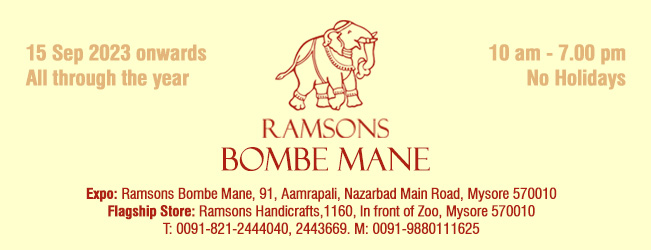Q1. How have the board games been significant aspect of cultural heritage
of the country? Are there ways you can explain in how history and its study
or...
Thursday, September 8, 2016
2016 Bombe Mane Brochure
Mysuru is gripped by the festive season of Dasara. Among multitudes of rituals, pujas and festivities, each and every household is busy mustering their doll treasures onto a temporary stepped scaffolding. This is for the annual doll festival, Bombe Habba which is a phenomenon distinctly ‘Mysuru’ in its flavour and appeal.
Ramsons Kala Pratishtana heralds this Bombe Habba with its 12th edition of Bombe Mane. A veritable congregation of dolls under one roof, each deftly crafted by the magical fingers of craftsmen and women from Karnataka, Tamil Nadu, Puducherry, Bengal, Andhra Pradesh, Uttar Pradesh and other places.
2016 marks the birth centenary of M.S. Subbulakshmi, the greatest exponent of Classical Karnataka music of this century. Bombe Mane commemorates this event by proudly introducing three new dolls depicting the divine balladeer Narada, Saint Kanaka Dasa and Saint Purandara Dasa. Narada is the first teacher of music, Purandara Dasa is the grand doyen of Karnataka music while his contemporary Kanaka Dasa is a composer par excellence. Together, they are the Karnataka Sangeetha Trimurthi.
A huge majestic elephant, caparisoned in costumed cloaks of vivid colours, walking with a steady gait, a liveried mahout seated and behind him securely fastened is the 750 kg golden howdah within which placed on a cushion is the idol of the presiding deity of the Mysuru, the Goddess Chamundeshwari. Before and behind this ponderous pachyderm, the 'Ambari Anay' (the elephant which carries the howdah), come royal attendants, the mounted corps, folk dancers and camel riders. This is the Jumboo Savari which is the cynosure of all eyes. This year, RKP has designed Jumboo Savari procession and skilled craftsmen have created the 68 pieces set in clay and paper mesh. The heroic Veeragasay troupe, Vajra Mushti wrestling scene, the folk dance-form of Somana Kunita along with the standard bearers are a part of this set.
This year's Special Display section of Bombe Mane has different themes. The recent royal wedding in Mysuru has brought joy to many a Mysurean. So the first special display section of Bombe Mane is dedicated to the weddings of the Wadiyar rulers and their kin. Rare vintage photographs of the marriages of royalties from the house of Wadiyars will be on display along with other memorabilia.
The second special display is Sri Krishna as the caretaker of cows with an emphasis on the diversity of cattle breeds of India - Amrit Mahal, Baragur, Hallikar, Javari, Kangayam, Kenkatha, Nagori, Ponwar, Lal Kandhari, Krishna, Kerighar, Khilari, Dangi, Malvi, Raathi, etc. Such diversity of heirloom cattle heritage is unique to India and this cattle legacy has nurtured thousands of generations of Indians. Bombe Mane celebrates this bovine heritage of India. Come, celebrate our land, our culture, our cattle. Come to Bombe Mane.
Friday, June 3, 2016
Miniature Kitchen Utensils - Papier Machie

This set of papier machie miniature kitchen set (Aatada Samanu in Kannada and Choppu Saman in Tamil) is made up of a traditional terracotta stove (olay), wicker basket (butti), grinder stone (rubbugallu), stone pounder (onakay-oralu), mill-stone (beesuvakallu), masala grinder (ariyuva kallu), winnow (moraa) and a pot (madikay). The cloth-stuffed doll of a female home-maker is not a part of the set. We have this kitchen set as well as the doll in stock. This makes a nice gift for children who enjoy games in which they can role-play as a home-maker.
Sunday, February 7, 2016
Making of Kokeshi Dolls
In the video, Yasuo Okazaki woodturns solid blocks into the head and body using just a few tools. Okazaki’s “Naruko” style of making the dolls.
This is similar to the Channapatna lathe turned wooden dolls. Lathe turned crafts were not unlnown to India and Indian artists. We can still see hand-turned wooden game-counters and other highly artistic wooden utensils created in this craftform in Gujarat and Rajasthan. Massive chlorite schist pillars with beautiful rings in the Hoysala temples are proof of lathe turning techniques using elephants.
Mysore Maharaja sent artists from Mysore to Japan to learn modern process of wooden turning (As seen in the video) before 1950s. Upgrading their skills, artists returned to Mysore and taught the same to local artisans and set up small units to manufacture.
Artist M.J. Shuddodhana was one of the artists who was sent to Japan and later he worked in Channapatna for a few years. At Channapatna, Shuddodhana invited two of his best students - G.L.N. Simha and another person to embellish the products with paintings.
Subscribe to:
Posts (Atom)










